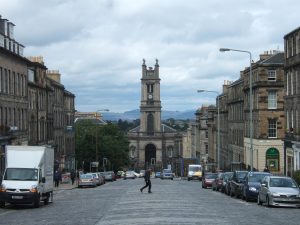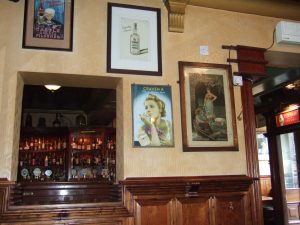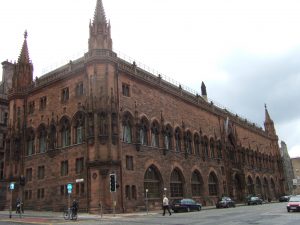I love Edinburgh – though I have to confess to avoiding it when it’s at its busiest, during the Festival and at the peak Christmas/Hogmanay season. But those two periods aside, I never tire of the city which seems to me to have the perfect combination of history and hostelries existing cheek by jowl – because let’s face it, you need to nourish the body and soul as well as the mind! What’s more, it’s the perfect size of city for walking and strolling around, conveniently divided neatly into bite size pieces of Old and New Town, with the added bonus of Leith if you have a third day to spend there. I blogged recently about a day out in the Old Town, so now it’s time to cross what was once the Nor’ Loch to the New Town.
 Way back in the 1750s the Old Town of Edinburgh, the heartland of the Enlightenment, was frankly a pretty rank place to live, with open sewers running down the streets and towering tenements which housed far too many people with too few sanitary provisions, and were treacherously easy to set on fire. When a six storey tenement collapsed, killing one of the occupants, the city Council were finally forced into taking action. The Nor’ Loch (now Princess Street Gardens) was drained. The North Bridge, a massive structure almost seventy feet high, opened up access to the land north of the existing city boundaries. Work on the New Town of Edinburgh could begin.
Way back in the 1750s the Old Town of Edinburgh, the heartland of the Enlightenment, was frankly a pretty rank place to live, with open sewers running down the streets and towering tenements which housed far too many people with too few sanitary provisions, and were treacherously easy to set on fire. When a six storey tenement collapsed, killing one of the occupants, the city Council were finally forced into taking action. The Nor’ Loch (now Princess Street Gardens) was drained. The North Bridge, a massive structure almost seventy feet high, opened up access to the land north of the existing city boundaries. Work on the New Town of Edinburgh could begin.
When you take in the beautiful symmetry of the original New Town, the magnificent architecture of the Georgian terraces, the grandeur of Charlotte square and St Andrews square bookending the main thoroughfare, and the huge green space that is Queen’s Street Gardens, you can’t help but admire the visionary civic planning of the Edinburgh City Council of its day. Can you imagine, nowadays, given the political in-fighting, the conflicting agendas of planning officials and developers, of residents and retailers, trying to get something on such a grand scale kicked off? No, neither can I! But Edinburgh pulled it off, and they did it in serious style.

In 1766, James Craig won the competition launched by Lord Provost George Drummond for the New Town’s layout. It was a simple plan, with George Street forming the backbone, Queen Street and Princes Street (originally called St Giles Street) running parallel on either side. Two leafy squares named for the patron saints of Scotland and England, Andrew and George, symbolised the union of the two parliaments which had taken place in 1707. What proportion of James Craig’s grand plan was actually built remains a mystery to this day, however, because no copies of his winning design exist, but I think it’s fair to say that the essence of his vision was realised, even if it was built piecemeal by a host of different builders who were pretty much left to their own devices.
Charlotte Square (renamed from George Square in honour of George III’s queen) is the starting point of this walk.


Created by Robert Adam, who died without seeing it completed, Charlotte Square is one of the finest (and largest) examples of his work, and the only part of the original New Town built to a unified design. The ‘palace’ fronts were intended to make each side of the square look like one building instead of a terrace of individual houses, lending it a unique grace and harmony.

Charlotte Square is peppered with famous ex-residents. Alexander Graham Bell was born at Number 16; Joseph Lister at Number 9; and Earl Haig at Number 34. Bute House, the official residence of Scotland’s First Minister, is at Number 6. Number 7 Charlotte Square was the home of the Chief of the Lamont Clan (my local Argyll clan, whose castle was at Toward, one of my favourite cycle routes). Now administered by the National Trust, the interior has been preserved as a typical example of a Georgian town house. I must confess to finding some of the staff a bit sniffy on my visit, chastising me for having the audacity to take photos, and one of them almost had a coronary when I touched the range in the kitchen. But it’s a lovely house. I’ve used a couple of the rooms in Strangers at the Altar, and I don’t doubt that I’ll borrow some more when I next set a book in Edinburgh – which surely, has to be soon!
 If you’re already in need of sustenance, head for the atmospheric vaults of Whigham’s Wine Bar at the corner of Charlotte Square and Hope Street. This is a lovely place with cavern-like booths lit by candles, awash with ambiance. There’s an excellent choice of wines by the glass, and a really nice bistro too, which showcases Scottish seafood.
If you’re already in need of sustenance, head for the atmospheric vaults of Whigham’s Wine Bar at the corner of Charlotte Square and Hope Street. This is a lovely place with cavern-like booths lit by candles, awash with ambiance. There’s an excellent choice of wines by the glass, and a really nice bistro too, which showcases Scottish seafood.
To continue the walk, go down North Charlotte Street at the north east corner of the square, then turn right along Albyn Place. Take a left down Wemysss Place and turn right into Heriot Row.

 Number 17 Heriot Row was the home of Robert Louis Stevenson. It was from his small bedroom at the top of this house that he watched ‘Leerie’, the lamplighter immortalised in his poem of that name, carry out his duties each night. If you’re a Stevenson fan then a visit to the Writer’s Museum in the Old Town is well worth it, they have stacks of memorabilia and early editions.
Number 17 Heriot Row was the home of Robert Louis Stevenson. It was from his small bedroom at the top of this house that he watched ‘Leerie’, the lamplighter immortalised in his poem of that name, carry out his duties each night. If you’re a Stevenson fan then a visit to the Writer’s Museum in the Old Town is well worth it, they have stacks of memorabilia and early editions.
 My favourite pit stop is nearby. Kay’s Bar (yes, there is a link!) can be found by turning left into India Street then right into Jamaica Street. Kay’s is one of Edinburgh’s hidden gems if you like atmospheric, old-fashioned boozers, with a wide selection of real ales and whisky served in the last surviving early 19th Century house on the street. It’s tiny, and at lunchtimes full of local business men, but there’s a fire in winter, and a cosy little back room library where you can relax and soak up the ambiance.
My favourite pit stop is nearby. Kay’s Bar (yes, there is a link!) can be found by turning left into India Street then right into Jamaica Street. Kay’s is one of Edinburgh’s hidden gems if you like atmospheric, old-fashioned boozers, with a wide selection of real ales and whisky served in the last surviving early 19th Century house on the street. It’s tiny, and at lunchtimes full of local business men, but there’s a fire in winter, and a cosy little back room library where you can relax and soak up the ambiance.
To continue, return to Heriot Row and turn left, keeping Queen Street Gardens on your right.
The gardens were once part the grounds of the town house belonging to the Earl of Wemyss on Queen Street, which runs parallel to Heriot Row. Professor James Simpson lived at 52 Queen Street. In 1847 he fell asleep after inhaling chloroform through a napkin, an experiment which led him to pioneer the use of the gas in surgery, particularly his own specialist area of gynaecology. Queen Victoria was one of the early beneficiaries. Further along, at Number 8, the Royal College of Physicians incorporates another house designed by Robert Adam.

Returning to Heriot Row, pause at the top of Howe Street to take in the view of St Stephen’s church in Stockbridge at the bottom of the hill, and beyond it the Firth of Forth with the Fife coast beyond. From Heriot Row turn left into Dundas Street.
Third street down on the right is Cumberland Street, home to the Cumberland Bar, a classic Edwardian saloon. Cumberland Street is named for King George III’s brother, the Duke of Cumberland. In 1746 Bonnie Prince Charlie was hiding in the Highlands following his defeat at the battle of Culloden. ‘Butcher’ Cumberland, as the Duke came to be known, ordered that no quarter be shown to Charlie’s supporters, and pursued the prince remorselessly across the Highlands, encouraging his men to burn, pillage, rape and murder as they went.


Despite its association with the murdering Duke, the Cumberland is a delightful and welcoming pub. The various interconnecting saloons and snugs are sparsely but attractively decorated with lots of old pub and whisky mirrors on display. There’s an open fire in winter and a leafy beer garden in summer, making this Edwardian gem worth a visit any time of year.
To continue the walk, turn right as you leave the Cumberland Bar and walk up Dundonald Street, then turn left into Drummond Place.
Named for Lord Drummond, this is the most elegant part of the second phase of the New Town development. Sir Compton McKenzie, author of Whisky Galore, stayed at Number 31. Nearby in Great King Street, Thomas de Quincey spent four years at Number 9, swamped by debt and a slave to the drug which gave its name to his most famous work Confessions of an Opium Eater (which was part of my research for the opening scenes of Rumours that Ruined a Lady). JM Barrie, author of Peter Pan, lived as a young man at Number 3.

At Drummond Place turn right, turn left up Dublin Street and continue up to the National Portrait Gallery on the corner of Queen Street.
The first purpose-built gallery in the world, the façade statuary is a veritable roll-call of Scottish history, including William Wallace, Robert the Bruce and Mary, Queen of Scots. This is one of Edinburgh’s many free museums, and worth going in for a wander (or a toilet stop if you’ve religiously followed my pub recommendations!) just to take a look at the astonishing interior.
Continue up North St Andrew Street to St Andrew’s Square in the direction of Princes Street.

There is little left of the original St Andrew’s Square save the façade of the town house built for Sir Laurence Dundas in 1776 and now the headquarters of the Royal Bank of Scotland. Sir Laurence ‘acquired’ the site originally intended for St Andrew’s Church, which was subsequently built on George Street instead.
One of the New Town’s first residents was David Hume. His house no longer exists, but a plaque in nearby South St David Street commemorates the site. Hume was more revered in his lifetime for his History of England than for the philosophical works for which he is more famous today, and which earned him the nickname The Great Infidel. On July 7th 1776 Hume summoned James Boswell to his New Town home: he was dying, and wished to say goodbye to his friends (in fact, he took another seven weeks before finally departing this life). Boswell, who was above all a voracious voyeur, recorded every detail of the evening’s conversation in his journal.
A more recent literary figure, Sir Walter Scott, resided in poverty at 6 North St David Street, and later spent his last two nights in Scotland just round the corner at the Douglas Hotel, 25 St Andrew’s Square.
Back in St Andrew’s Square, just past the Royal Bank of Scotland, turn left into West Register Street.


If you visit just one of my recommended hostelries, make it the Café Royal. It’s a magnificent and opulently decorated Victorian gin-palace with a stunning Oyster Bar restaurant attached (take a peak through the doors if you’re daunted by the rather astronomical prices). Benjamin Franklyn is one of the industrial pioneers commemorated on the antique tiled walls, and if you’re really, really lucky, you’ll get to sit in one of the comfiest leather banquettes in town. Full to bursting in the evenings and at weekends, mid-afternoon is the best time to fully appreciate its seductive charms. The bar food is also excellent (I recommend the oysters and smoked salmon).

But if you’ve managed to resist eating till now then you must be ravenous. Why not take a wander through the parallel mews of Thistle, Hill and Young Streets that separate George Street and Queen Street? These houses were originally built for stabling and servants quarters and are now extremely sought-after apartments with an eclectic mix of pubs – yes, more pubs including author Ian Rankin’s favourite, the Oxford bar – posh shops and eateries. If your taste runs to French bistro food, I can highly recommend Café St Honore, or the more reasonable Café Marlayne, but there are any number of alternatives.
Hopefully I’ve inspired you to plan a trip to Edinburgh, if not to follow exactly in my footsteps, at least to explore it for yourself. I’ve certainly inspired myself. I am definitely going to write another set book there very soon. Well, as you know, for a writer research is critical. It’s a hard life, but someone has to do it!
Slange var!


Comments
2 responses to “A Walk Through Edinburgh’s New Town: History and Hostelries”
A lovely description of my lovely adopted city. I would also recommend a stroll along the water of Leith and a stop off at either of the cafes in the two nearby Galleries of Modern Art.
I have done the Water of Leith walk, though not for quite a while and I’ve always started it from further on, joining from Haymarket. I did visit the Gallery of Modern Art recently though not the café – I got distracted by an ice-cream booth in the gardens. I’m back in Edinburgh for another three days in October though, and once again looking for new things to do…